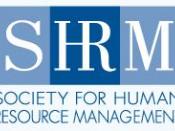TABLE OF CONTENTS
1.0 Introduction 1
1.0 Competitive Edge in Managing People 2
1.11 Roles and Accountability 2
1.12 Four Criteria for Competitive Edge 2
1.13 Gaining Competitive Advantage through People 3
2.0 The Importance of SHRM 3
2.1 Strategic Human Resource Management 3
2.2 Table: Why Human Resource Strategy? 4
3.0 Achieving Competitive Edge 4
3.1 The best - fit school of SHRM 5
3.2 Resource-based view of the firm (RBV) 6
3.3 Best - Practice SHRM: high - commitment models 7
3.4 Approaches to Managing People 8
Conclusion 11
1.0 Introduction
The field of human resource management (HRM) has undergone significant changes in today's turbulent environment. Both the practices and profession of HRM have changed dramatically due to the emergence of new economic paradigm which characterized by massive competition, globalization, innovation and creativity, speed, the advancement of information and technology, short cycle product and quality and also the importance of intangible assets, specifically human resources.
Human resources in now seen as new source of organizations' competitive advantage. The importance of human resource department and their roles has become a hotly debated issue. (Source: Ian Beardwell and Len Holden; "Human Resource Management" - A Contemporary Perspective; Second Edition; FINANCIAL TIMES PITMAN PUBLISHING. Pp45-68)
Definition of SHRM
Strategic human resource management (SHRM) takes these ideas one step further by emphasizing the need for HR plans and strategies to be formulated within the context of overall organizational strategies and objectives, and to be responsive to the changing nature of the organization's external 'environment' (i.e. its competitors, the national arenas). A strong implication of SHRM theory is that HR plans and strategies should be developed on a long-term basis, taking into account likely changes in the society, industrial relations systems, economic conditions, legislation, global and technological issues, as...



Good
an plagiarized and fully informative essay
0 out of 0 people found this comment useful.